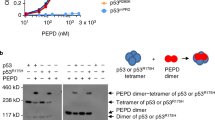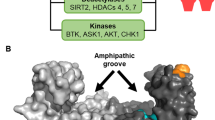Abstract
The low molecular weight compound PRIMA-1 and the structural analog PRIMA-1MET, also named APR-246, reactivate mutant p53 through covalent binding to the core domain and induce apoptosis in tumor cells. Here, we asked whether PRIMA-1MET/APR-246 can rescue mutant forms of the p53 family members p63 and p73 that share high sequence homology with p53. We found that PRIMA-1MET/APR-246 can restore the pro-apoptotic function to mutant TAp63γ and TAp73β in tumor cells but has less effect on TAp73α. Moreover, PRIMA-1MET/APR-246-stimulated DNA binding of mutant TAp63γ and induced expression of the p53/p63/p73 downstream targets p21 and Noxa. The reactivation of mutant p53, p63 and p73 by PRIMA-1MET/APR-246 indicates a common mechanism, presumably involving homologous structural elements in the p53 family proteins. Our findings may open avenues for therapeutic intervention in human developmental disorders with mutations in p63.
This is a preview of subscription content, access via your institution
Access options
Subscribe to this journal
Receive 50 print issues and online access
$259.00 per year
only $5.18 per issue
Buy this article
- Purchase on Springer Link
- Instant access to full article PDF
Prices may be subject to local taxes which are calculated during checkout






Similar content being viewed by others
References
Bernassola F, Oberst A, Melino G, Pandolfi PP . (2005). The promyelocytic leukaemia protein tumour suppressor functions as a transcriptional regulator of p63. Oncogene 24: 6982–6986.
Buhlmann S, Putzer BM . (2008). DNp73 a matter of cancer: mechanisms and clinical implications. Biochim Biophys Acta 1785: 207–216.
Bykov VJ, Issaeva N, Selivanova G, Wiman KG . (2002a). Mutant p53-dependent growth suppression distinguishes PRIMA-1 from known anticancer drugs: a statistical analysis of information in the National Cancer Institute database. Carcinogenesis 23: 2011–2018.
Bykov VJ, Issaeva N, Shilov A, Hultcrantz M, Pugacheva E, Chumakov P et al. (2002b). Restoration of the tumor suppressor function to mutant p53 by a low-molecular-weight compound. Nat Med 8: 282–288.
Bykov VJ, Issaeva N, Zache N, Shilov A, Hultcrantz M, Bergman J et al. (2005a). Reactivation of mutant p53 and induction of apoptosis in human tumor cells by maleimide analogs. J Biol Chem 280: 30384–30391.
Bykov VJ, Zache N, Stridh H, Westman J, Bergman J, Selivanova G et al. (2005b). PRIMA-1(MET) synergizes with cisplatin to induce tumor cell apoptosis. Oncogene 24: 3484–3491.
Cam H, Griesmann H, Beitzinger M, Hofmann L, Beinoraviciute-Kellner R, Sauer M et al. (2006). p53 family members in myogenic differentiation and rhabdomyosarcoma development. Cancer Cell 10: 281–293.
Celli J, Duijf P, Hamel BC, Bamshad M, Kramer B, Smits AP et al. (1999). Heterozygous germline mutations in the p53 homolog p63 are the cause of EEC syndrome. Cell 99: 143–153.
Chan WM, Siu WY, Lau A, Poon RY . (2004). How many mutant p53 molecules are needed to inactivate a tetramer? Mol Cell Biol 24: 3536–3551.
Chipuk JE, Maurer U, Green DR, Schuler M . (2003). Pharmacologic activation of p53 elicits Bax-dependent apoptosis in the absence of transcription. Cancer Cell 4: 371–381.
Corn PG, Kuerbitz SJ, van Noesel MM, Esteller M, Compitello N, Baylin SB et al. (1999). Transcriptional silencing of the p73 gene in acute lymphoblastic leukemia and Burkitt's lymphoma is associated with 5' CpG island methylation. Cancer Res 59: 3352–3356.
de Stanchina E, Querido E, Narita M, Davuluri RV, Pandolfi PP, Ferbeyre G et al. (2004). PML is a direct p53 target that modulates p53 effector functions. Mol Cell 13: 523–535.
Demma MJ, Wong S, Maxwell E, Dasmahapatra B . (2004). CP-31398 restores DNA-binding activity to mutant p53 in vitro but does not affect p53 homologs p63 and p73. J Biol Chem 279: 45887–45896.
Flores ER, Sengupta S, Miller JB, Newman JJ, Bronson R, Crowley D et al. (2005). Tumor predisposition in mice mutant for p63 and p73: evidence for broader tumor suppressor functions for the p53 family. Cancer Cell 7: 363–373.
Fogal V, Gostissa M, Sandy P, Zacchi P, Sternsdorf T, Jensen K et al. (2000). Regulation of p53 activity in nuclear bodies by a specific PML isoform. EMBO J 19: 6185–6195.
Ghioni P, Bolognese F, Duijf PH, Van Bokhoven H, Mantovani R, Guerrini L . (2002). Complex transcriptional effects of p63 isoforms: identification of novel activation and repression domains. Mol Cell Biol 22: 8659–8668.
Gonzalez S, Perez-Perez MM, Hernando E, Serrano M, Cordon-Cardo C . (2005). p73beta-Mediated apoptosis requires p57kip2 induction and IEX-1 inhibition. Cancer Res 65: 2186–2192.
Grob TJ, Novak U, Maisse C, Barcaroli D, Luthi AU, Pirnia F et al. (2001). Human delta Np73 regulates a dominant negative feedback loop for TAp73 and p53. Cell Death Diff 8: 1213–1223.
Guo X, Keyes WM, Papazoglu C, Zuber J, Li W, Lowe SW et al. (2009). TAp63 induces senescence and suppresses tumorigenesis in vivo. Nat Cell Biol 11: 1451–1457.
Helton ES, Zhu J, Chen X . (2006). The unique NH2-terminally deleted (DeltaN) residues, the PXXP motif, and the PPXY motif are required for the transcriptional activity of the DeltaN variant of p63. J Biol Chem 281: 2533–2542.
Kaghad M, Bonnet H, Yang A, Creancier L, Biscan JC, Valent A et al. (1997). Monoallelically expressed gene related to p53 at 1p36, a region frequently deleted in neuroblastoma and other human cancers. Cell 90: 809–819.
Kawano S, Miller CW, Gombart AF, Bartram CR, Matsuo Y, Asou H et al. (1999). Loss of p73 gene expression in leukemias/lymphomas due to hypermethylation. Blood 94: 1113–1120.
Lambert JM, Gorzov P, Veprintsev DB, Soderqvist M, Segerback D, Bergman J et al. (2009). PRIMA-1 reactivates mutant p53 by covalent binding to the core domain. Cancer Cell 15: 376–388.
Lambert JM, Moshfegh A, Hainaut P, Wiman KG, Bykov VJ . (2010). Mutant p53 reactivation by PRIMA-1(MET) induces multiple signaling pathways converging on apoptosis. Oncogene 29: 1329–1338.
Mills AA, Zheng B, Wang XJ, Vogel H, Roop DR, Bradley A . (1999). p63 is a p53 homologue required for limb and epidermal morphogenesis. Nature 398: 708–713.
Olivier M, Eeles R, Hollstein M, Khan MA, Harris CC, Hainaut P . (2002). The IARC TP53 database: new online mutation analysis and recommendations to users. Hum Mutat 19: 607–614.
Osada M, Ohba M, Kawahara C, Ishioka C, Kanamaru R, Katoh I et al. (1998). Cloning and functional analysis of human p51, which structurally and functionally resembles p53. Nat Med 4: 839–843.
Ozaki T, Naka M, Takada N, Tada M, Sakiyama S, Nakagawara A . (1999). Deletion of the COOH-terminal region of p73alpha enhances both its transactivation function and DNA-binding activity but inhibits induction of apoptosis in mammalian cells. Cancer Res 59: 5902–5907.
Pochampally R, Li C, Lu W, Chen L, Luftig R, Lin J et al. (2000). Temperature-sensitive mutants of p53 homologs. Biochem Biophys Res Commun 279: 1001–1010.
Rökaeus N, Klein G, Wiman KG, Szekely L, Mattsson K . (2007). PRIMA-1(MET) induces nucleolar accumulation of mutant p53 and PML nuclear body-associated proteins. Oncogene 26: 982–992.
Rinne T, Brunner HG, van Bokhoven H . (2007). p63-associated disorders. Cell Cycle 6: 262–268.
Schmale H, Bamberger C . (1997). A novel protein with strong homology to the tumor suppressor p53. Oncogene 15: 1363–1367.
Scoumanne A, Harms KL, Chen X . (2005). Structural basis for gene activation by p53 family members. Cancer Biol Ther 4: 1178–1185.
Shen J, Vakifahmetoglu H, Stridh H, Zhivotovsky B, Wiman KG . (2008). PRIMA-1MET induces mitochondrial apoptosis through activation of caspase-2. Oncogene 27: 6571–6580.
Stiewe T, Theseling CC, Putzer BM . (2002). Transactivation-deficient Delta TA-p73 inhibits p53 by direct competition for DNA binding: implications for tumorigenesis. J Biol Chem 277: 14177–14185.
Strano S, Rossi M, Fontemaggi G, Munarriz E, Soddu S, Sacchi A et al. (2001). From p63 to p53 across p73. FEBS Lett 490: 163–170.
Su X, Paris M, Gi YJ, Tsai KY, Cho MS, Lin YL et al. (2009). TAp63 prevents premature aging by promoting adult stem cell maintenance. Cell Stem Cell 5: 64–75.
Suh EK, Yang A, Kettenbach A, Bamberger C, Michaelis AH, Zhu Z et al. (2006). p63 protects the female germ line during meiotic arrest. Nature 444: 624–628.
Tomasini R, Tsuchihara K, Wilhelm M, Fujitani M, Rufini A, Cheung CC et al. (2008). TAp73 knockout shows genomic instability with infertility and tumor suppressor functions. Genes Dev 22: 2677–2691.
Trink B, Okami K, Wu L, Sriuranpong V, Jen J, Sidransky D . (1998). A new human p53 homologue. Nat Med 4: 747–748.
Ueda Y, Hijikata M, Takagi S, Chiba T, Shimotohno K . (1999). New p73 variants with altered C-terminal structures have varied transcriptional activities. Oncogene 18: 4993–4998.
van Bokhoven H, Hamel BC, Bamshad M, Sangiorgi E, Gurrieri F, Duijf PH et al. (2001). p63 Gene mutations in EEC syndrome, limb-mammary syndrome, and isolated split hand-split foot malformation suggest a genotype-phenotype correlation. Am J Hum Genet 69: 481–492.
Vousden KH, Lu X . (2002). Live or let die: the cell's response to p53. Nat Rev Cancer 2: 594–604.
Yang A, Kaghad M, Wang Y, Gillett E, Fleming MD, Dotsch V et al. (1998). p63, a p53 homolog at 3q27-29, encodes multiple products with transactivating, death-inducing, and dominant-negative activities. Mol Cell 2: 305–316.
Yang A, Schweitzer R, Sun D, Kaghad M, Walker N, Bronson RT et al. (1999). p63 is essential for regenerative proliferation in limb, craniofacial and epithelial development. Nature 398: 714–718.
Yang A, Walker N, Bronson R, Kaghad M, Oosterwegel M, Bonnin J et al. (2000). p73-deficient mice have neurological, pheromonal and inflammatory defects but lack spontaneous tumours. Nature 404: 99–103.
Zache N, Lambert JM, Wiman KG, Bykov VJ . (2008). PRIMA-1MET inhibits growth of mouse tumors carrying mutant p53. Cell Oncol 30: 411–418.
Zeng X, Zhu Y, Lu H . (2001). NBP is the p53 homolog p63. Carcinogenesis 22: 215–219.
Acknowledgements
We thank Dr Jiandong Chen, H Lee Moffitt Cancer Center, for the ts mutant p63/p73-expressing cells, and Dr Bert Vogelstein, Johns Hopkins Oncology Center, for the HCT116 cells. This work was supported by EU 6th Framework Program within the EPISTEM Integrated Project (LSHB-CT-2005-019067).
Author information
Authors and Affiliations
Corresponding author
Ethics declarations
Competing interests
KGW and VJNB are cofounders and shareholders of Aprea AB, a company that develops p53-based cancer therapy, and KGW is a member of its board.
Additional information
Supplementary Information accompanies the paper on the Oncogene website
Rights and permissions
About this article
Cite this article
Rökaeus, N., Shen, J., Eckhardt, I. et al. PRIMA-1MET/APR-246 targets mutant forms of p53 family members p63 and p73. Oncogene 29, 6442–6451 (2010). https://doi.org/10.1038/onc.2010.382
Received:
Revised:
Accepted:
Published:
Issue Date:
DOI: https://doi.org/10.1038/onc.2010.382
Keywords
This article is cited by
-
APR-246 induces apoptosis and enhances chemo-sensitivity via activation of ROS and TAp73-Noxa signal in oesophageal squamous cell cancer with TP53 missense mutation
British Journal of Cancer (2021)
-
Oligonucleotide Therapeutics as a New Class of Drugs for Malignant Brain Tumors: Targeting mRNAs, Regulatory RNAs, Mutations, Combinations, and Beyond
Neurotherapeutics (2019)
-
Master regulatory role of p63 in epidermal development and disease
Cellular and Molecular Life Sciences (2018)
-
A balancing act: orchestrating amino-truncated and full-length p73 variants as decisive factors in cancer progression
Oncogene (2015)
-
Drugging the p53 pathway: understanding the route to clinical efficacy
Nature Reviews Drug Discovery (2014)



